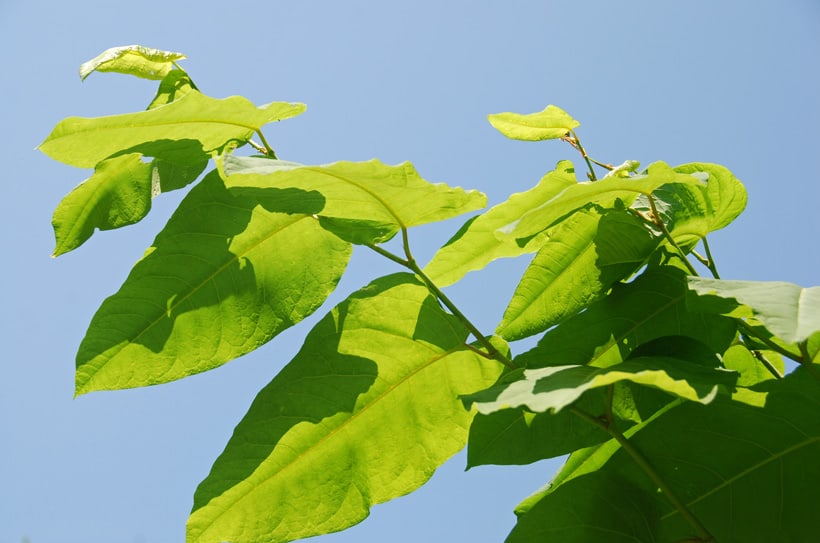Giant knotweed and Japanese knotweed both arrived in Europe and the UK as exotic Asiatic plants to be used in fashionable gardens. The two plants share similarities but have distinct differences.
It should be understood that when Japanese knotweed was brought to Europe by a noted Dutch horticulturist in the 1800s, only one female plants was imported.
This means that the rapid reproduction of Japanese knotweed in Europe is the result of the plant’s ability to adopt to different partners. Giant knotweed is one of the preferred reproductive partners for Japanese knotweed.
Giant knotweed
The Latin name form Giant knotweed is Fallopia sachalinensis. The species is indigenous to the island of Sakahlin, an island north of Japan. Like Japanese knotweed, it was brought to Europe to provide a tempting option to high end gardening enthusiasts.
Giant knotweed shares some physical similarities with its cousin, Japanese knotweed. It can grow to heights of 4 meters and has leaves that range from 20 to 40 centimetres.
Like Japanese knotweed, Giant knotweed also has flowering leaves that are greener and more rounded than the leaves of its cousin. The leaves of Giant knotweed plants are rounded at the base and often have scattered hairs on the underside.
Giant knotweed has reddish shoots that first emerge in the early spring. The shoots grow rapidly and can achieve heights of 4 meters quite quickly. At the same time, the roots of Giant knotweed extend deep into the ground, about 2 meters vertically and range horizontally up to 15 or 20 meters. The plant is a voracious eater. Food is stored in the stout rhizomes so that as the shoots are hindered by certain natural elements like frost, the food reserves in the rhizomes are unaffected.
This allows the plant to survive UK winters and come back quickly and wildly.
The rhizomes develop pink coloured modules in early spring. From these modules, shoots begin to sprout as early as April. However, Giant knotweed stems from previous years may still be present and can generate new shoots for up to another 12 months.
The more established the Giant knotweed, the woodier the stocks. These seem to increase in mass as the plants ages. They continue to generate horizontal spreading and creeping rhizomes that can spread under the surface of the ground.
The Spread of Giant knotweed
Giant knotweed only reproduces for vegetative purposes. Studies of the plant indicate that the species can produce viable seeds but the more conventional way for the plant to spread is by encroaching on established clumps or by the spread of small pieces of the plants. Once Giant knotweed invades an area, in even the most minute manner, it is stubborn and will take root.
If pieces of the plant float downstream it will often grow where it takes settles. Like Japanese knotweed, Giant knotweed will take over an area forcing native plants to decline and eventually fail.
Also, like Japanese knotweed, the handling of Giant knotweed is a stressful and careful undertaking. Only licensed landfills can accept the plant for waste. There is currently no easy way to dispose of either species.
Gardeners that attempt to remove the plants are in for a considerable ongoing battle, especially during the growing season. The tenacious character of the two plants is undeniable as they have disrupted public water and sewer lines and caused foundations to be compromised.
Detection and Elimination
In the UK, the best way to handle Giant knotweed and Japanese knotweed is to contact a licensed professional as soon as the plants are identified. If you think the plants have arrived at your property, in your water lines or are beginning to surface in your foundations, do not hesitate to contact a professional. The quicker you act, the better your chance of effective removal.
For more information about Giant knotweed or Japanese knotweed, get in touch with us today. Call 0800 389 1911 or contact us online.




